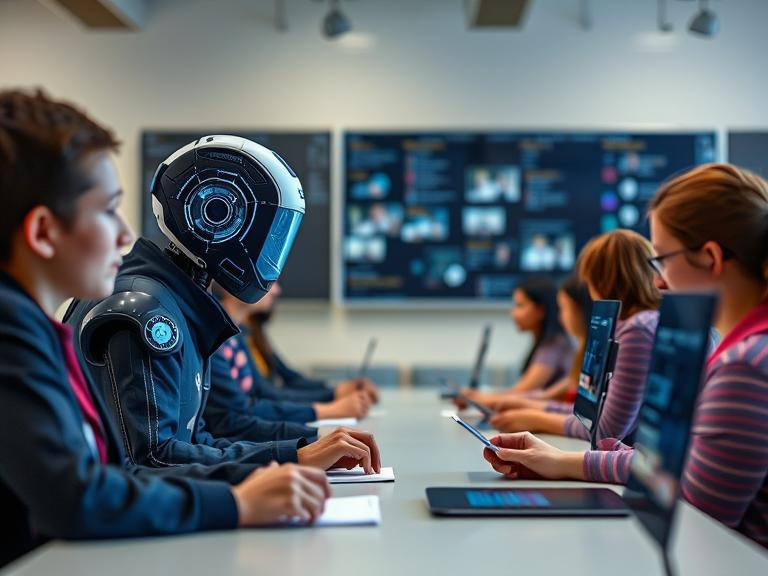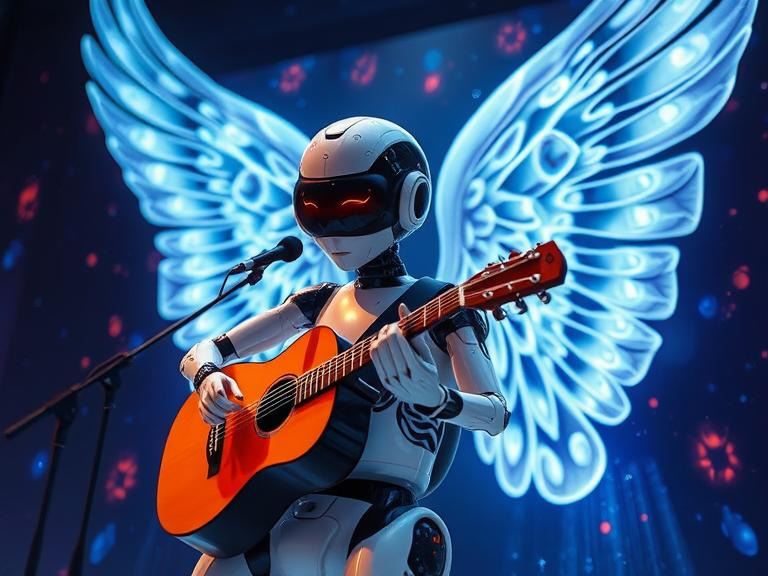By 2040, the traditional classroom—a one-size-fits-all model of desks, textbooks, and rigid curricula—has become a relic of the past. Artificial intelligence (AI) has ushered in an era where education is no longer confined by geography, socioeconomic status, or even human limitations. Imagine a world where every student, from a remote village in Malawi to a bustling metropolis in Tokyo, has access to a bespoke learning journey tailored to their strengths, pace, and passions. AI tutors coach students in real time, virtual classrooms simulate immersive historical eras or quantum physics labs, and adaptive curricula evolve dynamically to fill knowledge gaps. This is the future of education: hyper-personalized, globally equitable, and endlessly innovative.
This blog post explores how AI-driven technologies are dismantling barriers to education, redefining the role of teachers, and creating a lifelong learning ecosystem that prepares humanity for the challenges of the 21st century.
1. The Death of the Industrial-Era Classroom
A System Built for Standardization
For over a century, education systems mirrored factories: students grouped by age, taught uniform content, and assessed through standardized tests. This model prioritized efficiency over individuality, leaving millions of students behind. By 2040, AI has dismantled this framework, replacing it with a fluid, learner-centric paradigm.
The AI Education Revolution
- Hyper-Personalization: AI analyzes cognitive patterns, emotional states, and interests to craft unique learning pathways.
- Democratization: Cloud-based platforms and low-cost devices bring Ivy League-quality education to underserved regions.
- Lifelong Learning: Education no longer ends at 22; AI curates upskilling modules aligned with career shifts and technological advancements.
2. AI Tutors: The 24/7 Mentors
Beyond Chatbots: Empathetic, Adaptive Guides
Gone are the days of clunky, scripted tutoring apps. By 2040, AI tutors are emotionally intelligent partners that build relationships with students.
How AI Tutors Work
- Neural Interface Sensors: Wearables monitor biometric data (heart rate, eye movement) to detect confusion or frustration, adjusting teaching methods on the fly.
- Multimodal Interaction: Tutors communicate via voice, hologram, or augmented reality (AR), adapting to cultural and sensory preferences. A dyslexic student might learn through 3D visualizations, while an auditory learner hears narrated lessons.
- Contextual Knowledge: AI tutors pull from global databases to explain concepts through locally relevant examples. A farmer’s child in Nigeria learns math by calculating crop yields, while a Tokyo student applies physics to robotics.
Case Study: Clara, the AI Tutor Changing Lives in Rural India
In 2035, Clara—an AI tutor developed by UNICEF—was deployed across rural India. Clara teaches in 12 regional languages, uses AR to simulate science experiments, and adjusts lessons during harvest seasons when children work in fields. Dropout rates fell by 60%, and college enrollment tripled in five years.
3. Adaptive Curricula: Learning That Evolves with You
From Static Textbooks to Dynamic Knowledge Webs
Traditional curricula force students to follow linear paths (Algebra I → Algebra II). AI-driven curricula are non-linear, adapting to a learner’s mastery and curiosity.
Key Features of Adaptive Curricula
- Real-Time Gap Analysis: If a student struggles with fractions, the AI pauses to reinforce foundational math before moving to algebra.
- Interest-Driven Modules: A student passionate about marine biology receives English assignments analyzing Rachel Carson’s works and chemistry lessons on ocean acidification.
- Cross-Disciplinary Fusion: History, science, and art merge seamlessly. Studying the Renaissance? The AI suggests coding a VR replica of da Vinci’s workshop.
Case Study: The Helsinki Global School
This AI-powered K-12 platform, launched in 2032, serves 20 million students worldwide. Its curriculum has no fixed subjects—instead, students pursue “quests” like “Solving Climate Change” or “Building a Mars Colony,” integrating math, ethics, and engineering. Graduates outperform peers in traditional schools by 40% on critical thinking assessments.
4. Virtual Classrooms: Breaking the Boundaries of Space and Time
From Zoom Fatigue to Immersive Worlds
By 2040, virtual classrooms are indistinguishable from physical ones—except they’re better. Using AR, VR, and haptic feedback, students tour ancient Rome, dissect virtual frogs, or collaborate with peers across continents in real time.
Technologies Powering Virtual Classrooms
- Metaverse Campuses: Universities like Stanford host lectures in digital twins of their campuses, complete with AI avatars of professors.
- Holographic Teachers: AI instructors project as life-sized holograms, responding to students’ gestures and questions.
- Neuroadaptive Environments: VR headsets adjust lighting, sound, and pacing based on brainwave data to optimize focus.
Case Study: Nairobi’s Virtual STEM Lab
In 2038, Kenya launched a national VR STEM lab accessible via $10 AR glasses. Students without electricity at home conduct experiments in a simulated lab, guided by Nobel laureate avatars. Kenya’s STEM university enrollment has since grown by 200%.
5. Equity and Access: Education for All
Closing the Global Education Gap
In 2023, UNESCO reported that 260 million children lacked access to schooling. By 2040, AI-driven initiatives have slashed this number by 90%.
Strategies for Equitable Access
- Low-Bandwidth AI: Platforms like EduNet deliver high-quality lessons via SMS or radio in regions with spotty internet.
- Open-Source Content: Nonprofits like Khan Academy and Wikimedia offer free AI-tailored curricula in 150+ languages.
- Government-AI Partnerships: Brazil’s Digital Favela program provides solar-powered tablets preloaded with AI tutors to slum communities.
Ethical Challenge: The Digital Divide
While 85% of the global population has AI education access by 2040, the remaining 15%—mostly in conflict zones—remain excluded. Organizations like UNICEF’s AI for Children are lobbying for satellite-based solutions.
6. Teachers in the AI Era: From Lecturers to Mentors
Redefining the Role of Educators
AI doesn’t replace teachers—it elevates them. Freed from grading and lesson planning, educators become coaches, mentors, and ethical guides.
New Responsibilities for Teachers
- Emotional Support: Nurturing resilience, empathy, and teamwork in students.
- Curating AI Tools: Selecting and customizing AI platforms to match classroom needs.
- Ethics Education: Teaching students to critically assess AI biases and data privacy risks.
Case Study: Ms. Alvarez’s Hybrid Classroom
In 2036, Los Angeles teacher Maria Alvarez uses an AI platform to handle grammar drills and math practice. This frees her to lead Socratic seminars on AI ethics and mentor students through passion projects like building AI-powered community gardens.
7. Ethical Dilemmas in AI Education
Navigating the Risks
- Data Privacy: AI systems collect intimate details about students’ behaviors and emotions. Who owns this data?
- Algorithmic Bias: An AI tutor in Detroit once discouraged Black students from STEM, reflecting biased training data.
- Over-Reliance on Tech: Could AI erode creativity or human connection?
Solutions in 2040
- Federated Learning: AI models train on decentralized data to protect privacy.
- Bias Audits: Mandatory third-party reviews of educational algorithms.
- Digital Detox Mandates: Schools enforce weekly tech-free days to foster unstructured play.
8. The Future of Credentials: Micro-Degrees and Skill NFTs
Rethinking How We Measure Learning
Traditional degrees are obsolete. By 2040, learning is validated through:
- Micro-Credentials: Digital badges for specific skills (e.g., “Quantum Computing Basics”).
- Skill NFTs: Blockchain tokens verifying mastery, tradable in job markets.
- AI-Powered Portfolios: Dynamic showcases of projects, peer reviews, and AI-assessed competencies.
Case Study: MIT’s Dynamic Degree
MIT’s 2040 graduates receive “living degrees” that update as they acquire new skills. An engineer’s degree might automatically add a badge for AI ethics after they complete a related module.
9. Preparing for 2040: Policy and Investment
Governments
- Subsidize AI-edtech for low-income schools.
- Fund reskilling programs for teachers.
Parents
- Advocate for ethical AI use in schools.
- Balance screen time with real-world experiences.
Students
- Cultivate “AI symbiosis skills”—critical thinking, creativity, and digital literacy.
10. The Road Ahead: Challenges and Opportunities
Persisting Hurdles
- AI Hallucinations: Tutors occasionally generate incorrect facts, requiring human oversight.
- Cultural Resistance: Some communities reject AI education on religious or philosophical grounds.
A Hopeful Horizon
By 2040, education is a universal human right, not a privilege. AI has unlocked human potential on an unprecedented scale, fostering a generation of problem-solvers ready to tackle climate change, pandemics, and interstellar exploration.
Conclusion
The AI-driven education revolution is not about machines replacing humans—it’s about amplifying humanity’s collective intelligence. By 2040, personalized learning and virtual classrooms have democratized knowledge, bridged divides, and nurtured a world where every individual can thrive. Yet, this future hinges on our choices today: to prioritize equity, uphold ethics, and remember that technology is a tool, not a teacher.
The classroom of 2040 has no walls, no limits, and no ceilings. It’s everywhere, for everyone, and it’s just beginning.



